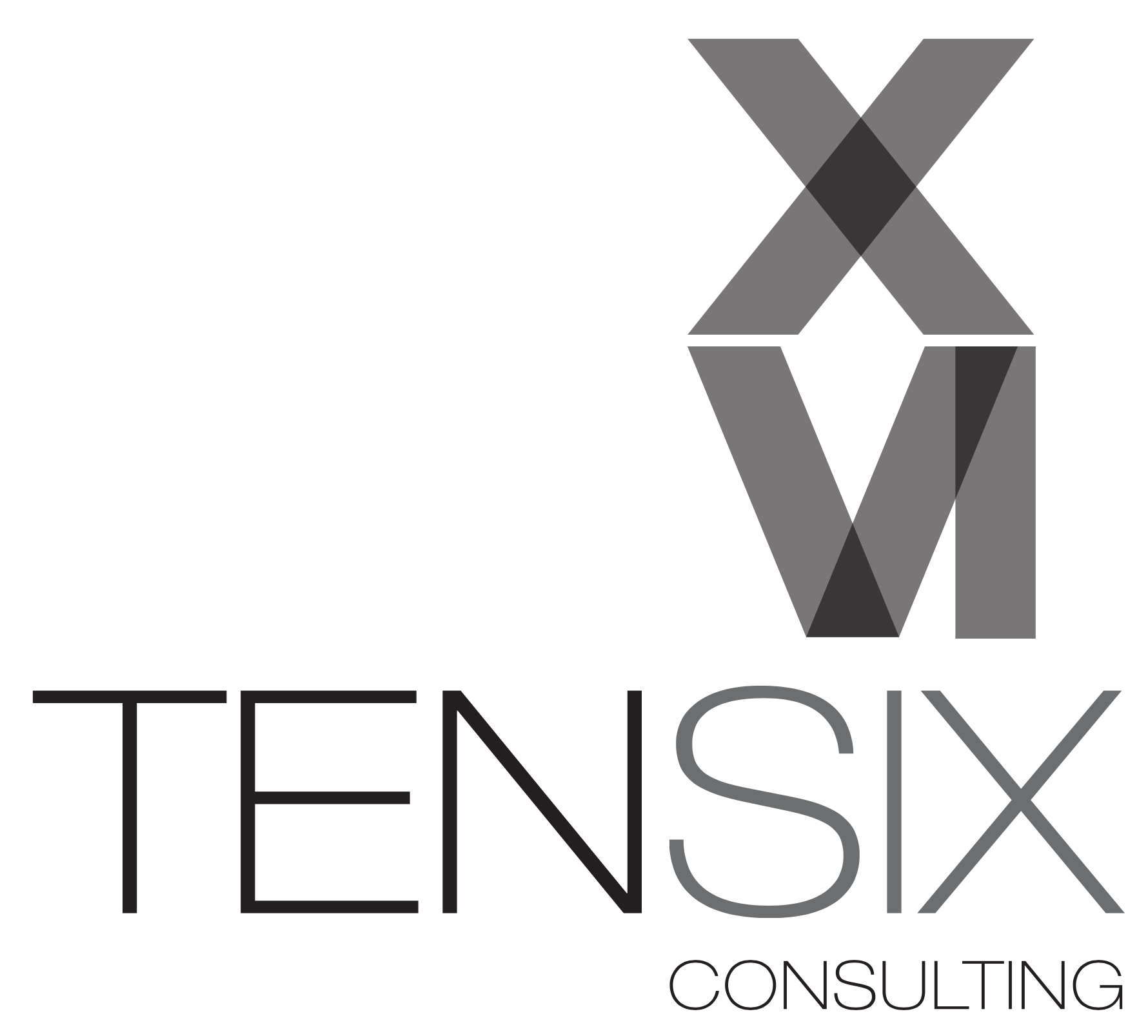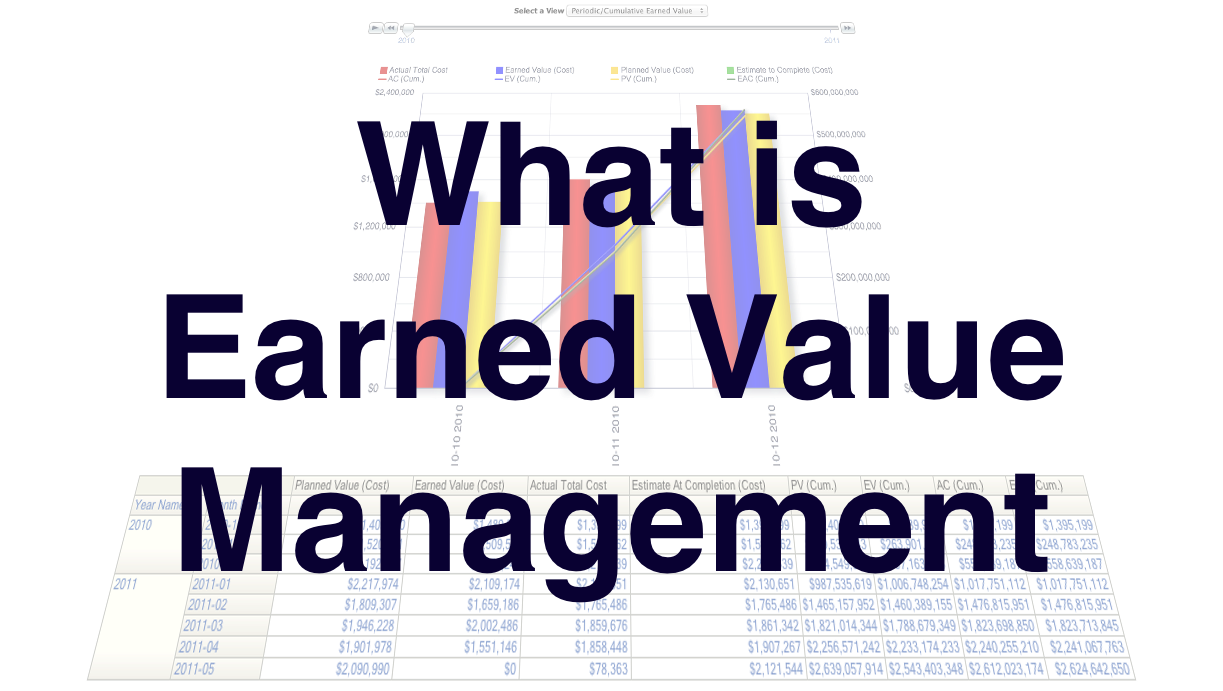
Have you been asked to look into earned value management for your organization in advance of bidding for a government contract? You’re in the right place. In this article, you’ll learn what is earned value management and how you can use it for your projects. We’ve put together a US contractor’s guide covering earned value from an EIA-748 standard perspective to help you get started.
What is Earned Value Management?
Earned Value Management (EVM) is a project management technique for managing performance. It integrates schedule, cost, and project scope to measure progress. The output is data you can use to forecast what the project will cost and how long it is likely to take.
That information provides useful management insight into what needs to be done to keep the project on track to deliver to the baselined dates and project budget. It is commonly used across all US government departments for large-scale projects.
What is IPM?
IPM stands for Integrated Program Management, which is both a division of Acquisition Data and Analytics (ADA) within the Department of Defense (DoD) and a new name for EVM itself. The division acts as a central point for all DoD guidance, training and policy relating to EVM/IPM and we may see in the years to come that the EVM terminology falls out of favour. Integrated Program Management certainly seems an easier piece of jargon to understand at face value, and perhaps better reflects what the method is all about: bringing together multiple aspects of a program or project to provide integrated performance tracking and management.
However, for the rest of this article we’ll use the standard, industry-accepted terminology of EVM, which is also still widely used in government circles and during the RFP and execution phases of contracts.
How does EVM work?
There are essential building blocks within the EVM method. The first is a time-phased budget where the project cost is spread over the project schedule in line with when the work is expected to take place.
As an example, on some projects, most of the cost might be upfront. The contractors might need to invest in hiring equipment or buying supplies. On other projects, the cost of the work might be relatively evenly phased throughout the life cycle, for example, where contractor resource time is the bulk of the cost and resource allocation is stable throughout.
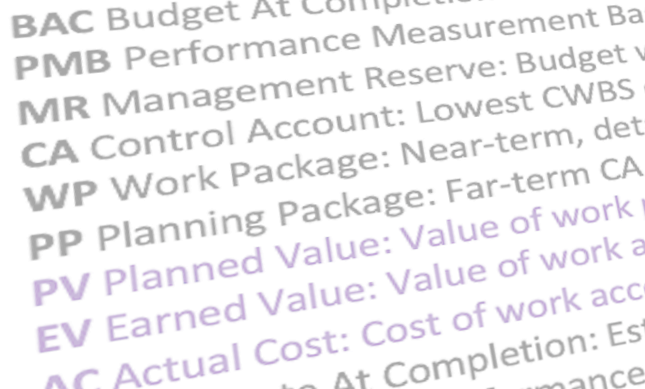 We call the time-phased budget the Planned Value (PV) of the project. You might also hear it called Budgeted Cost of Work Scheduled (BCWS).
We call the time-phased budget the Planned Value (PV) of the project. You might also hear it called Budgeted Cost of Work Scheduled (BCWS).
Another building block is the Integrated Master Schedule. “Integrated” means that your project timeline is integrated with the financial management tools. Earned Value Management software will manage this for you but you still need to put together a robust project schedule as a starting point.
Benefits of EVM
A study of completed Air Force contracts concluded that once you are 20% into a project, the cumulative Cost Performance Index for the project does not change by more than 10%. In other words, the cost efficiency of the project stabilizes early on during the work and becomes a powerful indicator of how well the project will perform going forward.
That indication of future performance is probably the main benefit we see for teams using EVM, but there are many others including:
- Reducing risk through identifying all aspects of the work
- Being able to compare projects against each other with standardized measures
- Being able to implement corrective actions, take decisions around the use of the management reserve
- Create a common understanding of actual expenditure with accurate forecasts
- Identify critical path activities and non-critical activities.
But what exactly is ‘Earned Value’?
Earned value is defined in the DoD Earned Value Management Implementation Guide as:
The sum of the budgets for completed work packages and completed portions of open work packages, plus the applicable portion of the budgets for level of effort and apportioned effort.
The Department of Defense calls it BCWP: Budgeted Cost of Work Performed, which does make sense.
Earned Value Management is a way of quantifying project progress and comparing actual progress to planned progress and actual money spent. Earned Value (EV) measures deliverable progress in monetary terms (value of work done), allowing the project manager to quantify progress as a monetary value.
The EV amount is the sum of the budget allocated for each piece of completed work, whether that’s a whole work package, or part of a control account.
“Value” in EVM terms can be interpreted as what has been achieved for the money invested to date. A project that is under budget might be celebrating their cost-saving, but if the project team hasn’t delivered anything close to what they were expecting for the money spent, they could have a run rate above what was planned.
So how do you work it out? Work packages don’t finish to coincide with standard reporting milestones, so it’s important to agree a way of measuring work-in-progress. That method must not be a subjective estimate because what we’re trying to get to is a standard, repeatable, justifiable approach to measuring progress – not the best guess of one of the team because humans aren’t known for their ability to provide bias-free estimates!
There are several methods for calculating EV to get round that problem, as shown in the table below. Whichever you choose, make sure everyone knows how progress will be measured and be sure to set up your software tools to match your preferred method. There are default options for earning value in Deltek Cobra, but if it’s appropriate, switch to another method that better fits the activity and the project reporting requirements.
| 0/100 | Value is earned when the work is complete. No partial value earned; it’s either 0% or 100% |
| 50/50 | Half the EV assigned when the task begins. The other half is assigned on completion. |
| 25/75 | 25% of EV assigned when the task begins. 75% assigned on completion |
| Units | Where units have the same budget value, assign EV based on units completed |
| Weighted milestones | Often used in contracts, EV is assigned in fractions that align to key project milestones. As each milestone is successfully reached, the relevant EV is assigned. |
| Percent complete | Used where it is possible to measure percent complete of project activities in an objective way. |
There is no mandated approach for measuring progress, and government contractors will be encouraged to identify products and milestones that the DoD calls technical progress indicators in the EVM System Interpretation Guide.
As you can see from the EV methods above, those approaches to allocating value to progress work well when the task is something tangible that relates to a defined product and where a metric can be produced. There are plenty of project tasks that don’t fit into that category, like the project management effort or procurement support tasks.
There is a way to assign EV to those activities, so you can manage your whole project. We do that with ‘level of effort’ which means splitting the EV for the task evenly throughout the project. It does not reflect actual effort but it gives you a way of acknowledging these activities.
There’s more about discrete effort, apportioned effort and level of effort in our guide to measuring progress for earned value.
EVM vs Earned Value Analysis
There is a lot of terminology that goes with this topic, and one area where people often get confused is the difference between EVM and EVA. Think of EVM as a broad approach to managing project progress and Earned Value Analysis as the math. EVM is a comprehensive performance management methodology that integrates scope, schedule and budget to create a performance measurement baseline against which progress is tracked.
EV analysis is a way of integrating the BCWP with other measures of project progress to produce useful project reporting. We cover the calculations and terminology you need to know in our guide to EV formula. If your role involves EV analysis, then we recommend you go deeper into this topic with one of our earned value management training courses.
What is an EVMS?
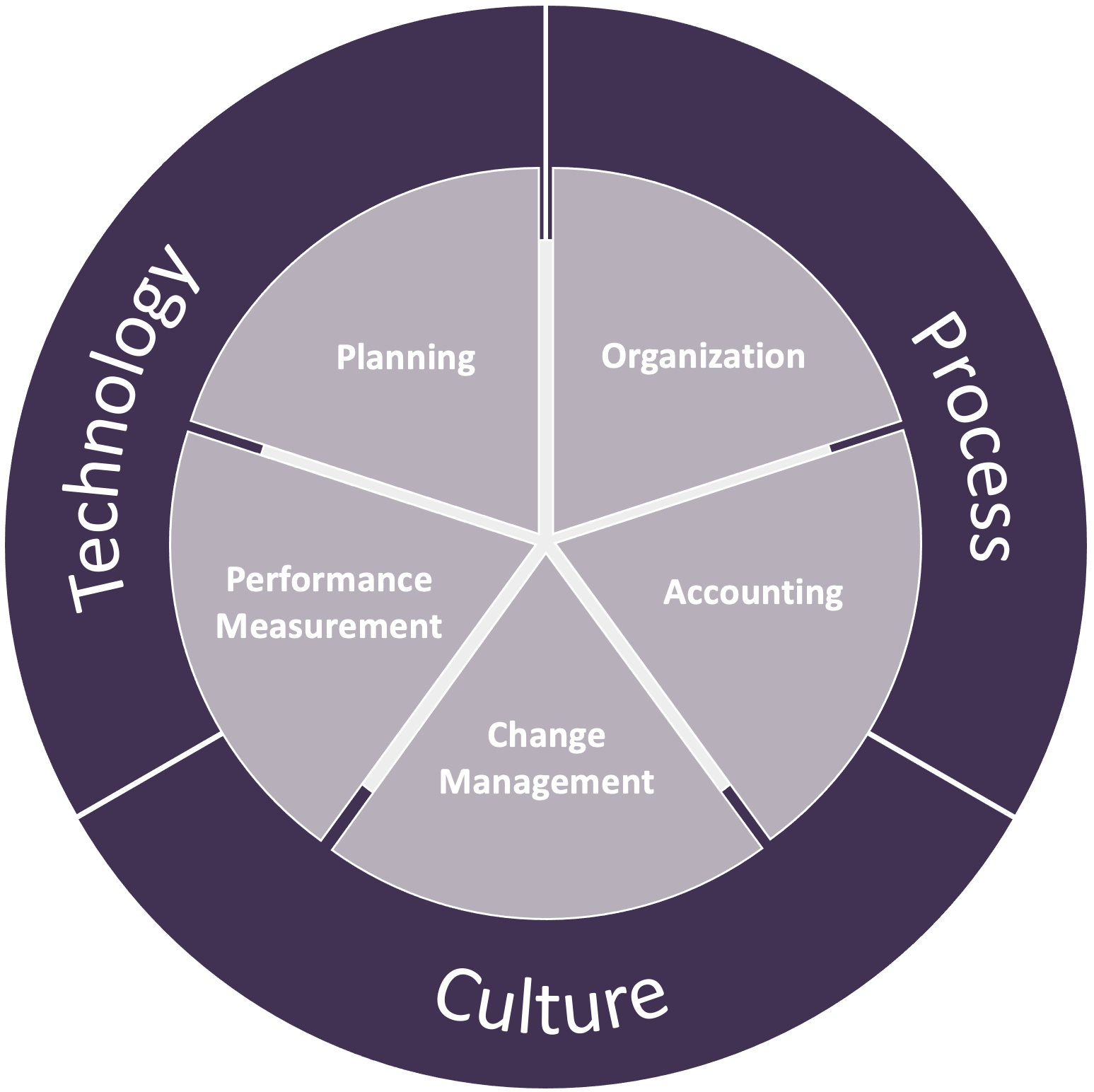
An Earned Value Management System (EVMS) is a set of processes, tools and the people who use them with the objective of managing project performance. It is not one piece of software but rather it represents an entire organizational system designed to track progress against a project baseline and integrate data from several sources. It provides insights into schedule performance, actual cost, schedule variances, cost variances and much more. It also assists with future project planning.
In your RFP for a contract, you will be expected to document how you meet (or will meet) the EVMS requirements.
Client case study: Oshkosh Defense
Oshkosh Defense was bidding on a large government contract that required an Earned Value Management System. While Oshkosh had experience in using Oracle Primavera P6, there was no cost engine in use. Oshkosh Defense asked Ten Six to assist in the creation and preparation of a winning Request For Proposal (RFP) response to its client.
We used our proven implementation methodology and proposal writing process steps to support Oshkosh in responding to the EVM mandate within their RFP, which covered everything from the initial assessment and gap analysis recommendations to creating flowcharts and documenting process flows.
Upon successful contract award, Oshkosh then asked Ten Six to support their EVM implementation.
Read more about our work with Oshkosh.
When is an EVMS used?
Put your EVMS in place as soon as you can. There are a number of Critical Decision (CD) milestones when working in line with the EIA-748 standard. The performance baseline for your project must cover the entire life cycle by CD-2, so it’s important to put your focus into getting that established quickly.
An EVMS is required on all projects for the Department of Energy (DOE) and Department of Defense (DoD) with a total project cost of $20m or greater. There are very specific requirements for the Adaptive Acquisition Framework. However, even if your contribution as a project contractor is not that value, you will be asked to report EVM data up through the project or program structure so project performance can be managed in a standardized way.
Who is involved in Earned Value Management?
 The main project management function involved in EVM is project controls. On a small team, you may have one specialist managing all the relevant aspects of the earned value ecosystem, but it’s common to have people in multiple roles spread the workload and become true experts in their fields. In addition, many project management roles are required to provide data and input into the system.
The main project management function involved in EVM is project controls. On a small team, you may have one specialist managing all the relevant aspects of the earned value ecosystem, but it’s common to have people in multiple roles spread the workload and become true experts in their fields. In addition, many project management roles are required to provide data and input into the system.
The main team members involved in creating the data for the EVMS are:
- Project manager (or program manager, or both)
- Scheduler(s)
- Estimators
- Control Account Managers
- Earned Value Analyst or Project Controls Analyst.
The EVMS certification process often requires interviews with leaders across the organization, with a view to understanding their knowledge of the processes and purpose of EVM. Project performance management is a wide-ranging area and requires involvement from other functions across the business too, such as finance team members, procurement and contract management, functional team leads, resource managers and planners.
All these individuals and groups should receive earned value management training relevant to their role.
What processes are involved in an EVMS?
Processes, and the documentation surrounding those processes, are scrutinized during the EVMS certification process. The process documentation covers the steps, procedures and people involved in managing the project. The goal is to standardize the way project progress is reported and to ensure accurate data is collected, inputted and produced.
EVM processes generally cover the following business areas:
- Project initiation, structure and organization
- Project estimating and scheduling
- Authorization, escalation and sign off
- Financial accounting and cost performance
- Change control
- Materials management
- Resource allocation
- Contract management.
You’ll be expected to provide a system description that outlines how your EVMS works and the processes involved as part of the certification effort. We can help you prepare an EVMS system description.
What software is involved in an EVMS?
You might be thinking that this is a lot of work to do without some tech to underpin ways of working and streamline what’s involved. That’s absolutely correct! As a government contract project manager, you are expected to have the right tools in place to link processes, people and data to provide reporting in a standardized format.
The software involved includes:
- Project scheduling tools e.g. Oracle Primavera P6
- Financial management tools e.g. ERP and accounting software
- Earned Value Management software e.g. Deltek Cobra
- EV reporting tools e.g. Deltek wInsight.
Your EMVS is an ecosystem that links all of these together.
There are many tools out there, so it’s important to choose software that fits within your existing IT estate and that (ideally) will automate many, if not all, of the integrations and data sharing requirements.
Most of our customers’ implementations use software that integrates to other tools in their organization, such as payroll or Active Directory for single sign-on or resource names. Those interfaces also need to be taken into account.
Your software also needs to be compliant with the EIA-748 Standard for EVMS, or IPM reporting requirements (which are extensive) for government contracts.
Read our Buyer’s Guide to EVM Software Selection for more information on choosing the right tools for your projects, or give us a call. As we are independent, we can help you select appropriate products for your needs.
Client case study: Wood
Wood asked Ten Six to assist with their Earned Value Management System for a major program for the USAF Space Fence Program. Wood requested a review of their EVMS processes and their alignment with Primavera P6 and Deltek Cobra with the goal of improving data quality and confidence in their existing implementation.
We focused on current configuration alignment with the month-end process and ensuring efficient data integration to support reporting requirements. This included reviewing the configuration and processes, assessing data quality and integrity, creating templates, and improving reports.
The improved efficiency that stemmed from the Ten Six implementation improvements allowed the Wood project team to reduce monthly recurring costs considerably.
Read more about our work with Wood Group.
How do you use the EV data?
The EV charts and reports are produced by your software (don’t try to generate them manually – life is too short). But if you can’t interpret the results, you can’t act on the information. It’s important to remember why you are collecting the data in the first place.
There are many useful insights that come out of your system reporting. In particular, project managers look for variance.
- A negative schedule variance means the project is behind schedule.
- A positive schedule variance means the project is ahead of schedule.
Variance analysis helps the team identify where the project is at risk of going off track (or has already gone off track). Those trends inform the plan for corrective actions.
EV is also part of your financial control tool suite so it offers insights into the budget. For example, you’ll get information about:
- Budget at Completion (BAC), which represents the forecasted budget for the project projected forward to project close.
- Budgeted Cost of Work Performed (BCWP), which is the value of work done to date.
- Budget Cost of Work Scheduled (BCWS), which is the value of the work that should have been done to date, as per the integrated baseline.
- Cost variance which is the difference between what the project planned to spend and what was actually spent for the time period.
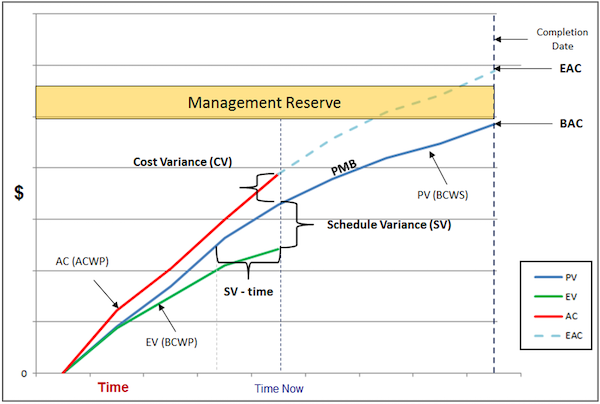 Share the reporting data with the project team, client and stakeholders so that the right actions can be taken next. There are specific ways and formatting requirements for sharing EV data with government agencies, so check the guidelines or ask us for help if you aren’t sure what to do.
Share the reporting data with the project team, client and stakeholders so that the right actions can be taken next. There are specific ways and formatting requirements for sharing EV data with government agencies, so check the guidelines or ask us for help if you aren’t sure what to do.
EVMS Certification
There are lots of moving parts in an EVMS and you can imagine the impact on overall project reporting if any of those elements are incorrectly configured. That’s why the certification process exists.
EVMS certification is required for government contractors. Often, it’s a condition of being able to move on with project work so gaining certification is an essential step. Where the total project cost is lower, contractors can self-certify their EVMS. However, for higher value contracts, there is a mandated certification process that is carried out by an external validation team.
The challenge with certification is that you normally need around three months of data processed through the system to evidence that your EVMS is set up effectively and producing the outputs that it should. Getting your system set up correctly from the very beginning will speed up this process.
Learn how we can help with EVMS certification.
Best practices for EVM
EVM has been around for a long time, so there are plenty of good practices and recognized approaches that help make your implementation and use more successful. For example, a study by the Joint Space Cost Council identified the following ways to improve the use of EVM principles:
- Choose the correct level for control accounts. Too low level and the overhead of managing detailed reporting may outweigh the benefit.
- The scheduling function is critical for reliable, useful data coming out of reports.
- Data quality problems result in stakeholders ignoring what the EVM indicators are telling them. Reliable data means people take reporting more seriously and results in a better-run program.
In this article, we covered a lot about earned value management and you learned the basics of what is required to meet the standards for government contracts. We spend a lot of time working with clients on best practice implementations and ensuring they are ready for certification review.
Post-contract, we support clients get ready for their Integrated Baseline Review, Progress Assessment Reviews, and more. We can help you too. Get in touch to find out how.
